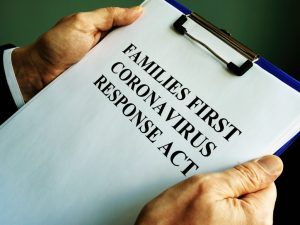Content Reviewed by:
Tucker Clagett •
March.31.2020
Vertified Content
Mar 31, 2020
| Read Time: 4 minutes

Two new federal laws take effect April 1, 2020. Both were created in response to the Covid-19 threat on March 18, 2020. Both provide significant new protections for employees. And, predictably, both are confusing and unclear!
Our firm does not handle employment law cases, but since these laws are of great interest to many of our clients now, I thought it would make a good blog post and newsletter subject.
Thanks to my law school friend Melissa Menkel McGuire – an excellent employment law attorney in Baltimore (who practices state wide and I highly recommend her services if you need one) – I understand these laws just well enough to explain the basics to our clients in plain English.
Take this as general advice, and see the link at the bottom of this post for detailed information, or call us and we can find you a good employment law attorney.
THE EMERGENCY FAMILY & MEDICAL LEAVE EXPANSION ACT
Many of you should be aware of the Family & Medical Leave Act (FMLA) which provides up to 12 weeks of unpaid leave to certain employees in some situations.
Now Congress has expanded the FMLA to provide benefits to more employees if they are unable to work (or telework) due to the need to care for a child whose school or day care is closed for reasons related to Covid-19. It is really focused on child care needs. And if your employer lets you telework then it doesn’t apply.
If you fit that definition, you are entitled to up to 12 weeks of leave. You can get paid for some or all of this too. The regulations on how much you can get paid are confusing and I will direct to the link at the bottom of this post if you want to figure that out.
But know that under this new expanded FMLA, you get paid leave instead of unpaid leave – for conditions related to Covid-19. Other conditions for which FMLA applies do not result in paid leave. Only reasons related to Covid-19 shutdowns will do it.
Here are some key things to know:
- It applies to all employers who employ more than 500 employees (including both full & part time employees).
- It applies to small businesses who have less than 50 employees. The original FMLA did not apply to these smaller businesses, so this is a very large expansion of the law. These small employers can apply for an exemption if they can prove granting the leave would jeopardize their ability to stay open, but it is very unclear how this will work in practice.
- Your employer may elect to exclude you from coverage if you are a health care provider or emergency responder.
- This law applies to both full and part time employees as long as they have been employed for at least 30 days.
- Generally, the employer has to restore you to the same job when you return, unless they can prove the job doesn’t exist due to economic realities when you come back.
If you thought you didn’t have the right to paid leave under the normal FMLA, then you may be pleasantly surprised to find out you do have that right now – under the circumstances mentioned above.
THE EMERGENCY PAID SICK LEAVE ACT
This law provides paid leave if you are unable to work or telework because you are under quarantine, advised to self-quarantine, have Covid-19 or Covid-19 symptoms and are seeking a diagnosis, are caring for someone who is in quarantine, or are caring for a child whose school or day care is closed due to Covid-19.
That’s a lot of varied circumstances, but know your reason for sick leave has to be directly related to Covid-19 and you have to be unable to work because of it.
If you qualify, you can get up to 80 hours of paid leave.
ONE BIG CAVEAT TO ALL THIS
These laws do not prevent your employer from closing their worksite or laying off employees. If they do that, they do not have to provide you with these benefits.
CONCLUSION
These are two pretty big laws that cover a lot of people. If you think you may be entitled to these rights, then click the link below and get some more answers. If you need an employment law attorney, call us and we will put you in touch with someone we recommend.
For all the details, the Q&A at the Department of Labor site can be found here.





